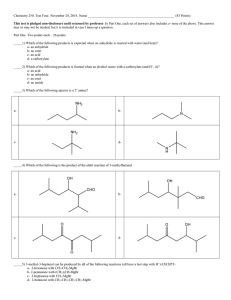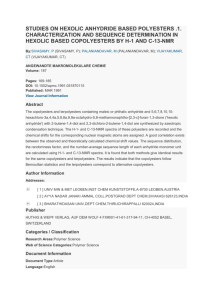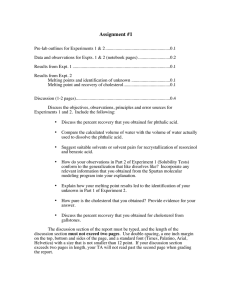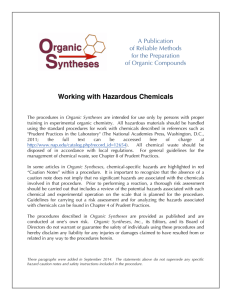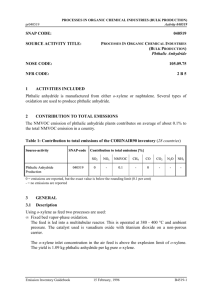International Journal of Metallurgical & Materials Science and Engineering (IJMMSE) ISSN 2278-2516
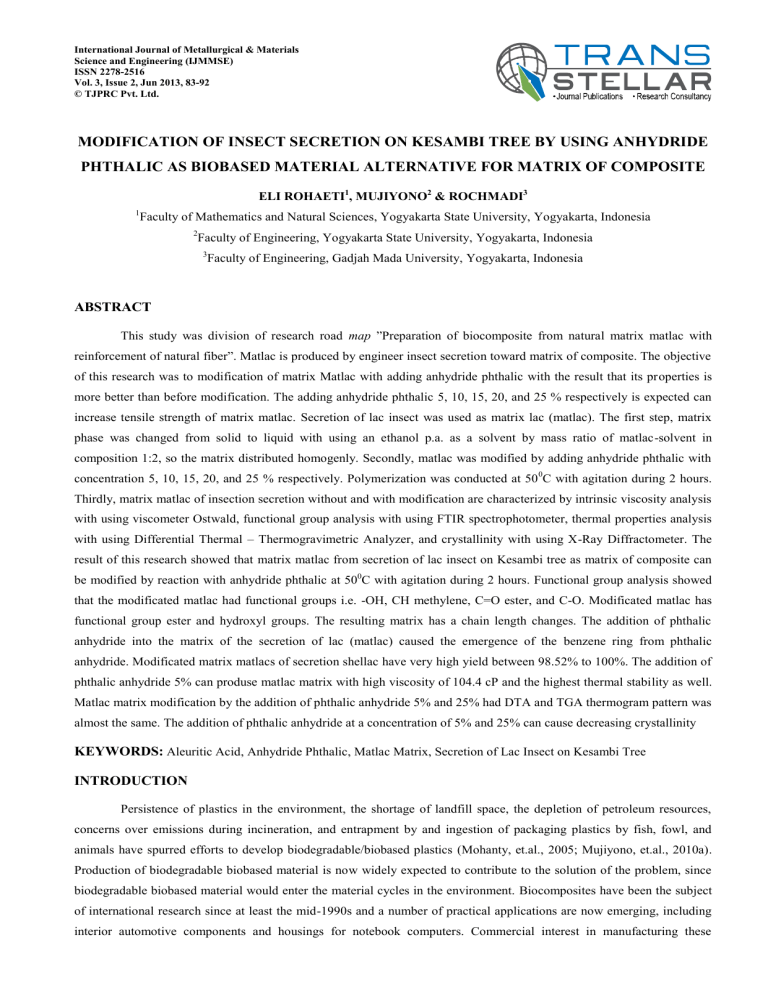
International Journal of Metallurgical & Materials
Science and Engineering (IJMMSE)
ISSN 2278-2516
Vol. 3, Issue 2, Jun 2013, 83-92
© TJPRC Pvt. Ltd.
MODIFICATION OF INSECT SECRETION ON KESAMBI TREE BY USING ANHYDRIDE
PHTHALIC AS BIOBASED MATERIAL ALTERNATIVE FOR MATRIX OF COMPOSITE
ELI ROHAETI
1
, MUJIYONO
2
& ROCHMADI
3
1
Faculty of Mathematics and Natural Sciences, Yogyakarta State University, Yogyakarta, Indonesia
2
Faculty of Engineering, Yogyakarta State University, Yogyakarta, Indonesia
3
Faculty of Engineering, Gadjah Mada University, Yogyakarta, Indonesia
ABSTRACT
This study was division of research road map ”Preparation of biocomposite from natural matrix matlac with reinforcement of natural fiber”. Matlac is produced by engineer insect secretion toward matrix of composite. The objective of this research was to modification of matrix Matlac with adding anhydride phthalic with the result that its properties is more better than before modification. The adding anhydride phthalic 5, 10, 15, 20, and 25 % respectively is expected can increase tensile strength of matrix matlac. Secretion of lac insect was used as matrix lac (matlac). The first step, matrix phase was changed from solid to liquid with using an ethanol p.a. as a solvent by mass ratio of matlac-solvent in composition 1:2, so the matrix distributed homogenly. Secondly, matlac was modified by adding anhydride phthalic with concentration 5, 10, 15, 20, and 25 % respectively. Polymerization was conducted at 50
0
C with agitation during 2 hours.
Thirdly, matrix matlac of insection secretion without and with modification are characterized by intrinsic viscosity analysis with using viscometer Ostwald, functional group analysis with using FTIR spectrophotometer, thermal properties analysis with using Differential Thermal – Thermogravimetric Analyzer, and crystallinity with using X-Ray Diffractometer. The result of this research showed that matrix matlac from secretion of lac insect on Kesambi tree as matrix of composite can be modified by reaction with anhydride phthalic at 50
0
C with agitation during 2 hours. Functional group analysis showed that the modificated matlac had functional groups i.e. -OH, CH methylene, C=O ester, and C-O. Modificated matlac has functional group ester and hydroxyl groups. The resulting matrix has a chain length changes. The addition of phthalic anhydride into the matrix of the secretion of lac (matlac) caused the emergence of the benzene ring from phthalic anhydride. Modificated matrix matlacs of secretion shellac have very high yield between 98.52% to 100%. The addition of phthalic anhydride 5% can produse matlac matrix with high viscosity of 104.4 cP and the highest thermal stability as well.
Matlac matrix modification by the addition of phthalic anhydride 5% and 25% had DTA and TGA thermogram pattern was almost the same. The addition of phthalic anhydride at a concentration of 5% and 25% can cause decreasing crystallinity
KEYWORDS:
Aleuritic Acid, Anhydride Phthalic, Matlac Matrix, Secretion of Lac Insect on Kesambi Tree
INTRODUCTION
Persistence of plastics in the environment, the shortage of landfill space, the depletion of petroleum resources, concerns over emissions during incineration, and entrapment by and ingestion of packaging plastics by fish, fowl, and animals have spurred efforts to develop biodegradable/biobased plastics (Mohanty, et.al., 2005; Mujiyono, et.al., 2010a).
Production of biodegradable biobased material is now widely expected to contribute to the solution of the problem, since biodegradable biobased material would enter the material cycles in the environment. Biocomposites have been the subject of international research since at least the mid-1990s and a number of practical applications are now emerging, including interior automotive components and housings for notebook computers. Commercial interest in manufacturing these
84 Eli Rohaeti, Mujiyono & Rochmadi products is driven by the derivation of the polymers from renewable sources as well as by their specific properties including biodegradability (Plackett and Vazquez, 2004; Mujiyono, et.al., 2010a)
Biocomposite with natural matrix developed more rapidly because they are more environmentally safer. The natural matrix was used in this experiment was obtained from Kesambi tree lac from secretion of lac insect. The lac is resinous compound which has special properties: biodegradable, non-toxic and provides immense employment opportunities (Mujiyono, et.al., 2010a). Naturally, the soft-bodied lac insects produced a resinous secretion which protects them from adverse environment. The major constituent of lac is the resin and other constituent of lac is the resin and other constituents present were: dye, wax, sugar, proteins, soluble salts, sand, woody matter, insect body debris. (Mujiyono, et. al., 2010b). Shellac is also produced from lac insect ( laccifier lacca ) that has an attractive material and economically important species (Sharma, et. al., 2005). The secretion of lac insect on Albazia tree (ISA) as a candidate feasible biobased matrix for biocomposite with the main constituent aleuritic acid (Mujiyono, et.al., 2010a). ISA disbursement method with aleuritic acid chemical structure can be done by using the solvent ethanol (Mujiyono, et.al., 2010a).
Reference study showed that the lac is secretion of lac insect. It is renewable, biodegradable versatile and has good bonding strength, non toxic resin, which leads great potency of lac as natural matrix for biocomposite. A feasibility of the matlac as natural polymeric matrix composite or green matlac composite reinforced by ramie-woven fiber has relatively the same tensile strength to the composite of polyester (Mujiyono, et.al., 2010a; Mujiyono, et. al., 2010c). The matlac matrix is well compatible with ramie, indicated by contact angle of about 30
0
(Mujiyono, et. al., 2010c). The biocomposite potents to be a novel material from renewable resources. Plain weave hybrid ramie–cotton fabrics were used as reinforcement in polyester matrix composites. The tensile strength of the composites was determined as a function of the volume fraction and orientation of the ramie fibers. Values of tensile strength of up to 338% greater than that of the matrix were obtained which shows the potential of the ramie fiber as reinforcement in lignocellulosic fiber composites. ( Paiva
Ju´nior, et. al., 2004) Biopolymer has been developed as natural matrix for composites, such as starch, soybean, and chitosan (Lanzilotta, et.al., 2002; Wollerdorfer and bader, Lodha and Netravali, 2002; Curvelo, et. al., 2001; Cyras, et. al.,
2001). Investigations were conducted to modification secretion of lac insect by esterification using phthalic anhydride. The objective of this research was modification and characterization of insect secretion on Kesambi tree as biobased material alternative for matrix composite.
MATERIALS AND METHODS
Materials
Natural matrix of biocomposite was prepared from secretion of lac insect that separated from Kesambi plant and collected. Ethanol p.a. from Aldrich Lab, Yogyakarta, Indonesia was used as lac solvent with composition 1:2. Secretion of lac insect is reacted with anhydride phthalic concentration 5, 10, 15, 20, and 25% m/m.
Equipment
Yield of reaction product was determined with gravimetry technique by using balance. Intrinsic viscosity of insect secretion with and without modification was measured by using viscometer Ostwald in Organic Chemistry Lab,
Yogyakarta State University, Yogyakarta. Infrared spectra were recorded on KBr pellets by using a Shimadzu FTIR spectrophotometer in Indonesia Islam University, Yogyakarta. Thermal properties of reaction product after modification were determined by using DTA-TGA analyzer in Leather Technology Academy, Yogyakarta. X-Ray diffractogram of modificated insect secretion was determined by using XRD diffractometer in Engineering Faculty, Gadjah Mada
University ,Yogyakarta.
Modification of Insect Secretion on Kesambi Tree by Using Anhydride 85
Phthalic as Biobased Material Alternative for Matrix of Composite
PROCEDURES
Sample Preparation
Natural matrix was prepared by solving secretion of lac insect into ethanol p.a. at a room temperature with mass ratio of 1:2 for 6 hours. Natural matrix was hereinafter referred as matlac (matric lac). Meanwhile, modificated matrix was prepared through esterification reaction between secretion of lac insect with anhydride phthalic. Reaction was conducted at
50
0
C with agitation during 2 hours. Afterward, nodificated matrix was ready to be characterized.
Characterization
Matrix from secretion of lac insect before and after modification by using anhydride phthalic is characterized yield by gravimetry technique, intrinsic viscosity by measuring flow time, functional group by using FTIR technique, thermal properties by using DTA-TGA technique, and crystallinity by using XRD diffractometer.
RESULTS AND DISCUSSIONS
Yield of Matrix Matlac from Modificated Secretion of Lac
Modifications carried out by adding phthalic anhydride into a liquid secretion shellac (matrix matlac of secretion of lac insect that are dissolved in ethanol with a ratio of 1:2) with modifier concentration 5, 10, 15, 20, and 25% m/m. The process of dissolving shellac in ethanol performed at room temperature to obtain a homogeneous liquid secretion of lac insect, further into the liquid matrix of SKL matlac modifier is added through esterification reaction at a temperature of
50
0
C and stirring for 2 hours. The reaction product obtained weighed next to obtain the data yield from each product as shown in Table 1.
Table 1: Yield of Modificated Secretion of Lac Insect
No
Matrix Matlac of Secretion of Lac Insect with Adding
1 Phthalic anhydride
Yield of Matrix (%) at Adding Modifier
5% 10% 15% 20%
99,04 98,57 100,00 99,52
25%
98,52
Based on the data from Table 1. indicated that the product matrix of secretion of lac insect has a very high yield between 98.52% to 100%. The addition of phthalic anhydride 15% into the matrix matlac of secretion of lac insect can produce 100% of the reaction product.
Intrinsic Viscosity of Modificated Natural Matrix Matlac from Secretion of Lac Insect
Matlac matrix of a modified secretion of lac insect was analyzed intrinsic viscosity using Ostwald viscometer.
Intrinsic viscosity for matlac matrix of secretion of lac insect before modification was 72.93 cP. Table 2. showed intrinsic viscosity data of modified matlac matrix. The intrinsic viscosity is a measure of the intrinsic ability of a polymer to increase viscosity in a given fluid. It is defined as the limit of the reduced viscosity as the polymer concentration approaches zero.
Table 2: Intrinsic Viscosity of Modificated Matrix from Secretion of Lac Insect
No
1
Matrix Matlac of Secretion of Lac Insect with Adding
Phthalic anhydride
Intrinsic Viscosity (mL/g) at Adding Modifier
5% 10% 15% 20% 25%
104,4 69,24 53,73 35,25 25,76
Based on the intrinsic viscosity in Table 2. it can be seen that the addition of phthalic anhydride 5% can increase the intrinsic viscosity of the matrix matlac. The existence of the benzene ring, which is part of the molecule of phthalic anhydride has the highest reactivity so that the addition of 5% concentration can be produced much longer molecular chain
86 Eli Rohaeti, Mujiyono & Rochmadi matrix or the highest intrinsic viscosity. However, the addition of as much as 25% of phthalic anhydride produces a matrix with the lowest intrinsic viscosity. This indicated that the optimum concentration for modification matlac of secretion of lac insect was the addition of phthalic anhydride by 5%. The high intrinsic viscosity means matlac matrix with the addition of 5% of phthalic anhydride has the highest molecular weight. The high molecular mass matlac matrix indicated the molecular chain length. The long-chain molecules that can affect the thermal stability and the transition temperature of the matrix. The intrinsic viscosity of a polymer is a function of many parameters, including polymer molecular weight and molecular weight distribution, polymer/solvent interactions, temperature, shear rate, branching, and copolymer composition. The molecular weight average obtained from viscosity measurements is the viscosity average molecular weight, Mv, whose value lies between Mn and Mw, but closer to Mw.
Requirements of a polymer matrix composites can be summarized from several references (Schwartz, 1984;
Feldman, 1989; Kavelin, 2005). First, the matrix must be able to withstand and protect the fiber. Thus the fiber matrix must be able to wrap properly and does not cause excessive internal strain between the fiber and the matrix. Second, the matrix must always be able to keep the fiber in place so it does not disintegrate. Third, the matrix must be able to distribute the load to the fibers. This means that the matrix must have a good bond to the fiber. The increasing chain length of matrix is expected to have thermal properties similar to hemp fiber composed of cellulose threads that have high thermal stability.
Furthermore, the increasing length of the molecular chain of matrix can certainly improve the mechanical properties of the resulting biocomposites.
Functional Groups of Matrix Matlac from Secretion of Lac Insect
Secretion of lac insect is composed of biobased material aleuritic acid is polar because it has a carbonyl functional group (C = O) (Mujiyono, et. al., 2010a). According to Bodner (2004), the electronegativity difference between carbon and oxygen is large enough to make the C = O tends polar. Carboxylic acid functional group (-COOH) at the end of the molecule has a tendency aleuric acidic nature of polar and soluble in water. Long alkyl chains, causing the molecules tend nonpolar and only the water-soluble fraction. Therefore, the method of disbursement aleuritic acid with the chemical structure of a matrix Matlac can be performed using ethanol solvent. Matrix matlac without modification and after modified with phthalic anhydride is shown in Figure 1. Based on FTIR spectra can be seen that the matrix before and after modified matlac showed absorption bands at specific wave numbers are almost the same. This shows that the functional groups of matrix before and after the modified similar qualitatively.
Matrix Matlac before the modified showed absorption bands more sharply than matlac matrix after modification.
After modification with phthalic anhydride 5% showed more broad absorption band especially at wave numbers indicating alcoholic functional groups-OH,-CH methylene group, an aromatic ring. The addition of phthalic anhydride indicated by absorption bands typical for aromatic ring molecules which are part of the phthalic anhydride has reacted with aleuritic acid of secretion of lac insect, ie at wave numbers of about 1500 cm
-1
.
The addition of as much as 25% of phthalic anhydride into matlac matrix showed more absorption bands widened again mainly on the wave number indicates the-OH and C = O ester groups and the presence of a new absorption band at -
1500 cm
-1
region. Furthermore, the addition of as much as 25% of phthalic anhydride appear two absorption bands around
1700 and 1720 cm
-1
indicating the presence of C = O hydrogen bond and C = O free. The existence of both types of the C
= O can amplify low intrinsic viscosity of the data matrix with the addition of phthalic anhydride to matlac 25%.
Increasing the hydrogen bond index (the hydrogen bonds) causing molecules in the matrix matlac at high concentrations would have reduced the lower the viscosity.
Modification of Insect Secretion on Kesambi Tree by Using Anhydride 87
Phthalic as Biobased Material Alternative for Matrix of Composite
Figure 1 : Spectra FTIR of Matrix Matlac from Secretion of Lac Insect (a) Before Modification, (b) After
Modification with Phthalic Anhydride 5%, and (c) After Modification with Phthalic Anhydride 25%
Based on FTIR spectra can be stated that the addition of phthalic anhydride in the matrix matlac of secretion of lac insect causing a reaction between aleuritic acid with phthalic anhydride reinforced by data showing the wave number of the additional benzene ring portion of the molecule of phthalic anhydride in a modified matrix. Then the wide absorption band at a wave number indicated the-OH and C = O groups. The presence of -OH and C = O to form hydrogen bonds to strengthen the intrinsic viscosity of the data, the lower the molecular chain length of the matrix matlac. Interpretation of functional groups for the matrix matlac before and after modified with phthalic anhydride can be seen in Table 3. Figure 2. showed chemical structure for modificated matrix of secretion of lac insect. The functional groups are often generated by the chemical reaction of phthalic anhydryde with hydroxyl group in aleuritic acid of matrix.
Wave Number of
Secretion of Lac Insect
3396.76
2930.63
2857.81
1713.11
1634.78
-
1463.62
1252.39
1161.92
1114.02
1047.00
Table 3: Interpretation of Functional Groups for the Matrix Matlac
Wave Number of Matrix with Adding Phthalic
Anhydride 5%
3383.80
2931.18
2859.75
1711.30
1637.32
1581.30
1450.35
1258.05
1144.08
1001.87
1047.01
Wave Number of Matrix with
Adding Phthalic Anhydride
25%
3396.33
2932.18
-2800
1727.74
1710.88
1535.40
1449.8
1290.28
1131.30
1075.08
1044.13
Functional
Group
-OH stretching
-CH
-CH
C=O ester
C=O ester
Benzene ring
-OH bending
C-O stretching
C-O stretching
C-O stretching
C-O stretching
88 Eli Rohaeti, Mujiyono & Rochmadi
All the FTIR peaks showed functional group characteristic of matrix matlac of secretion of lac insect before and after modification with phthalic anhydride, i.e. –OH, C=O, and C-O group, appear in all spectra. Closer inspection revealed two unique peaks in the spectrum of Matlac after modification with phthalic anhydride 25% m/m, one appearing around
1535 cm
-1
, arising from the stretching vibration of aromatic ring, and one at ~1727 cm
-1
, arising from the stretching vibration of the hydrogen bonding C=O group, both therefore due to the existence of aromatic ring and –C=O hydrogen bonding caused by chemical reaction when treated with phthalic anhydride.
FTIR analysis also allowed verification of ester bond formation in matrix before and after modification. All material before and after modification can be used as matrix in preparation biocomposite, because those materials had the same characteristic functional group, i.e. –OH and C=O, respectively (Chin-San Wu, 2007).
Figure 2: Chemical Structure of Modificated Matrix by Using Anhydride Phthalic
Thermal Properties of Matrix Matlac from Secretion of Lac Insect
The results of the analysis of thermal properties by using DTA-TGA is shown in Figure 3. Figure 3. DTA-TGA thermogram for matrix without and with modification through the addition of phthalic anhydride with 5% and 25%. Based on Figure 2. DTA thermogram showed that the thermogram pattern for matlac from secretion of lac insect without and with the addition of phthalic anhydride have almost the same pattern, ie a sharp endothermic peak at around 100
0
C.
Modification of Insect Secretion on Kesambi Tree by Using Anhydride 89
Phthalic as Biobased Material Alternative for Matrix of Composite
Figure 3: Thermogram DTA-TGA for Matrix Matlac of Secretion of Lac Insect (a) Addition of Phthalic Anhydride
5%, (b) Addition of Phthalic Anhydride 25%, (c) without Modification
Based on thermogram DTA, all matrix had glass transition. This showed that all matrix had amorphous region.
G lass transition is an character of amorphous region.
Glass transition temperature, Tg values characterized pure polymers, polymer blends, copolymers, as well as matrices in polymer-based composites. Tg as function of composition reflect miscibility (or lack of it) and determine all properties.
There is no glass transition temperature Tg; there is a glass transition region. The change from the glassy state into a liquid or a rubbery state is gradual. Tg values are reported by analogy with the melting temperature Tm values, so as to represent a region by a single number. While Tm values do not depend on the direction of the change (freezing a liquid, melting a solid) or on the change rate, the location of the glass transition region depends on both factors (Brostow, 2008).
Endothermic peak indicated the melting temperature of the matrix matlac without and with modification. Then the degradation temperature endothermic peak indicated by the rightmost (highest temperature) is shown by the matrix with the addition of 25% and the addition of 5% phthalic anhydride, and than secretion of lac insect without modification at a temperature of 380
0
C. Matlac matrix with the addition of phthalic anhydride has not shown any degradation temperatures up to 400
0
C temperature.
Based on TGA thermogram in Figure 3. showed that all matrix products from secretion of lac insect without and with modification thermogram showed almost the same pattern. The increasing of temperature can cause decreasing mass percent of matrix. This showed that increasing of temperature can cause depolymerization reactions or decomposition in matrix. Based on the pattern of the thermogram can be stated that with increasing temperature the mass matrix decreased or increased mass loss with increasing temperature. Matlac matrix of phthalic anhydride by the addition of 5% (a) has the highest thermal stability and higher than martiks matlac without modification (c). Matrix matlac with the addition of 25% phthalic anhydride showed a higher thermal stability than the matrix matlac without modification.
Matlac matrix of phthalic anhydride by the addition of 5% showed the mass loss below 5% at a temperature of
100
0
C, while the other matlac matrix of SKL and also the addition of 25% of phthalic anhydride has suffered a loss of mass of about 15-25 % at a temperature of 100
0
C. The difference in temperature required for thermal decomposition was probably due to modificated matrix having a more prohibitive effect movement of the polymer segments at higher mass
90 Eli Rohaeti, Mujiyono & Rochmadi percent ( Chin-San Wu, 2007) . At each temperature range, matlac matrix with the addition of phthalic anhydride showed the mass loss of 5% lower than the matrix without and with modification using phthalic anhydride 25%.
The Diffraction Patern of Matrix Matlac from Secretion of Lac Insect
X-ray diffraction was used to examine the crystalline structures of matrix before and after modification.
Crystallinity is a factor that can affect the mechanical properties of the material. Materials with high crystallinity will have mechanical properties such as stress at break higher as well. However, there are many other factors that can affect the mechanical properties of a material, such as chain length, branching, crosslinking, and molecular mass. The longer the chain, toughness and strength increase. This is due to the increase in chain interactions such as Van der Waals bonding.
Chains become stronger hold on its position in the matrix deformation and fragmentation, both high voltage and high temperature. Branching will increase the strength and toughness of the polymer. Crosslinks that many will increase the strength and toughness of the polymer. Similarly, the molecular mass increases will increase the mechanical strength of the polymer.
XRD patern of matrix with addition anhydride phthalic 5% and 25% and also matrix without modification can be seen in Figure 4. That showed that modification did not alter crystallinity peak at 10 and 20
0
of the base material, except modificated matrix by using anhydride phthalic 5% had disappeared crystallinity peak at 10
0
, changed to amorphous. The peak at 2θ = 18 0
, may be due to the formation of an ester carbonyl functional group, as described in the discussion of FTIR analysis (Chin-San Wu, 2007).
Figure 3: XRD Patern for Matrix Matlac of Secretion of Lac Insect (a) Addition of Phthalic Anhydride 5%, (b)
Addition of Phthalic Anhydride 25%, (c) without Modification
All XRD diffractogram of matrix similar to those reported by Chin-San Wu (2007). Based on XRD diffractogram, further c rystallinity of matrix matlac is measured as showing by Table 4. Matrix matlac of secretion of lac insect without adding modifier (before modification) had the highest c rystallinity and matrix matlac with adding phthalic anhydride 2 5% had the lowest c rystallinity.
Modification of Insect Secretion on Kesambi Tree by Using Anhydride 91
Phthalic as Biobased Material Alternative for Matrix of Composite
Table 4: C rystallinity of Matrix Matlac without and with Adding Phtalic Anhydride
No Matrix Matlac
1 Secretion of Lac Insect
2 Secretion of Lac Insect + phthalic anhydride 5%
3 Secretion of Lac Insect + 25%
C rystallinity (%)
72.59
65.57
60.62
Based on the calculation of crystallinity (Table 4.), Modifications to the matrix matlac of SKL with phthalic anhydride can lower crystallinity of course this can decrease the mechanical properties of the matrix. However, because many factors can affect the mechanical properties, only one molecular mass. Thus, because based on the measurement of flow time and the calculation of the intrinsic viscosity, the addition of phthalic anhydride 5 and 10%, (Table 2.) Can increase the intrinsic viscosity which means it can increasing molecular mass matrices, it is possible that the addition of anhydride phthalic can enhance the mechanical properties of the matrix.
CONCLUSIONS
Matrix matlac of secretion of lac insect can be modified by the addition of phthalic anhydride indicated by the presence of functional groups -OH, CH methylene, ester C = O, and C-O. The addition of phthalic anhydride into the matrix of the secretion of ticks lak matlac shown by the emergence of the benzene ring from phthalic anhydride. Matrix matlac of secretion of lac insect modified had very high yield between 89.09% to 100%. The addition of anhydride phthalic by 5% produced matlac matrix with a high of 104.4 mL/g viscosity and the highest thermal stability as well. Matlac matrix modification by the addition of phthalic anhydride 5% and 25% have DTA and TGA thermogram pattern is almost the same. The addition of anhydride phthalic at a concentration of 5% and 25% can decrease crystallinity of the secretion of matrix matlac.
ACKNOWLEDGEMENTS
In this opportunity, we would thank to State Minister for Education and Culture which gave fund to this research according to the decree of State Minister for Education and Culture, Indonesian Government No.12/SPI-
Stranas/UN34.21/2012 and Perhutani Unit II, West Java, Indonesia for providing secretion of lac insect.
REFERENCES
1.
Mohanty, A.K., Misra, M., Dzral, L.T., Selke, S.E., Harte, B.R. and Hinrichsen, G. (2005). ” Natural Fibers,
Biopolymers And Biocomposite: An Introduction.” Chapter 1 in Natural Fibers, Biopolymers, and biocomposite , edited by Mohanty, A.K., Misra, M., Dzral, L.T., CRC Press, Taylor and Francis Group, 6000 Broken Sound
Parkway NW, USA.
2.
Plackett, D., Vazquez, A. (2004). Natural polymer source, Chapter 7 in Green Composites. Polymer composites and the environment edited by Caroline Baillie, Woodhead Publishing Limited, Abington Cambridge, UK.
3.
Mujiyono, Jamasri, Heru S.B.R, J.P. Gentur S. (2010). Insect secretion on Albazia tree as biobased material alternative for matrix composite . Material Science and Research India, Volume 7 No. 1 Page No . 77-87 June
2010.
4.
Mujiyono, Jamasri, Heru S.B.R, J.P. Gentur S. (2010). Investigation and characterization of insect secretion on
Albazia tree as biobased material alternative for matrix composite . Material Science and Research India, Volume
7 No. 1 , pp. 37-48.
5.
Sharma, K. K., Jaiswal, A. K. and Kumar, K. K. (2006). Role of lac culture in biodiversity conservation: issues at
92 Eli Rohaeti, Mujiyono & Rochmadi stake and conservation strategy. Review article, Current Science , 894 Vol. 91, No. 7, pp 894-898.
6.
Mujiyono, Jamasri, Heru S.B.R, J.P. Gentur S. (2010). Mechanical Properties of Ramie Fibers Reinforced
Biobased Material Alternative as Natural Matrix Biocomposite .
International Journal of Materials Science, 5 (6),
811–824
7.
Paiva Ju´nior, C.Z., L.H. de Carvalho, V.M. Fonseca, S.N. Monteiro, J.R.M. d’Almeida. (2004). Analysis of the tensile strength of polyester/hybrid ramie-cotton fabric composites. Polymer Testing 23 (2), pp. 131–135.
8.
Lanzillotta, C., Pipino, A. and Lips, D. (2002). New functional biopolymer natural fiber composites from agricultural resources. In Proceedings of the Annual Technical Conference – Society of Plastics Engineers, San
Francisco, California , Vol. 2, pp. 2185–9.
9.
Wollerdorfer, M. and Bader, H. (1998). Influence of natural fibres on the mechanical properties of biodegradable polymers. Ind. Crop. Prod ., 8 (2), 105–12.
10.
Lodha, P. and Netravali, A.N. (2002). Characterization of interfacial and mechanical properties of ‘green’ composites with soy protein isolate and ramie fiber. J. Mater. Sci ., 37 (17), 3657–65.
11.
Ali, R., Iannace, S. and Nicolais, L. (2003). Effect of processing conditions on mechanical and viscoelastic properties of biocomposites. J. Appl. Polym. Sci ., 88 (7), 1637–42.
12.
Musaddad, M.A. (2007). Agribisnis Tanaman Rami , Penebar Swadaya, Depok, Jakarta, Indonesia.
13.
Munawar, S.S., Umemura, K., Kawai, S. (2006). Characterization of The Morphological, Physical, and
Mechanical Properties of Seven Nonwood Plant Fiber Bundles . J.Wood Science 53, pp.108-113.
14.
Schwartz, M.M. (1984). Composite Materials Handbook , McGraw-Hill Book Company, New York, USA.
15.
Feldman, D. (1989). Polymeric Building Materials . Published :Routledge; 1 edition, ISBN-13: 978-1851662692,
Taylor & Francis Group.
16.
Vasiliev, V.V, Morozov, E.V. (2001). Mechanic and Analysis of Composite Materials . Elsevier Science Ltd, The
Boulevard, Langford Lane, Kidlington, Oxford OX5 lGB, UK.
17.
Kavelin, K.G. (2005). Investigation of Natural Fiber Composites heterogeneity with respect to automotive structure. Thesis for degree of doctor at Delfi University of Tecnology, Netherland.
18.
Bodner, G.M. (2004). The Carbonyl Group , College of Science Chemical Education Devision Group, Purdue
University, West Lafayette, Indiana, USA. access date 12/25/2009 8:09:20.
19.
Curvelo, A.A.S., Carvalho, A.J.F. and Agnelli, J.A.M. (2001). Thermoplastic starch cellulosic fibers composites: preliminary results. Carbohyd. Polym ., 45 (2), 183–8.
20.
Cyras, V.P., Iannace, S., Kenny, J.M. and Vázquez, A. (2001). Relationship between processing conditions and properties of a biodegradable composite based on PCL/ starch and sisal fibers. Polym. Compos ., 22 (1) 104–10.
21.
Brostow, W., Chiu R., Kalogeras, I. M., and Dova A. V. (2008). Prediction of glass transition temperatures :
Binary Blends and Copolymers. Materials Letters , 62, 3152-3155.
22.
Chin-San Wu. (2007). Characterizing Composite of Multiwalled Carbon Nanotubes and POEg -AA prepared via
Melting Method. Journal of Applied Polymer Science , Vol. 104, 1328-1337.

